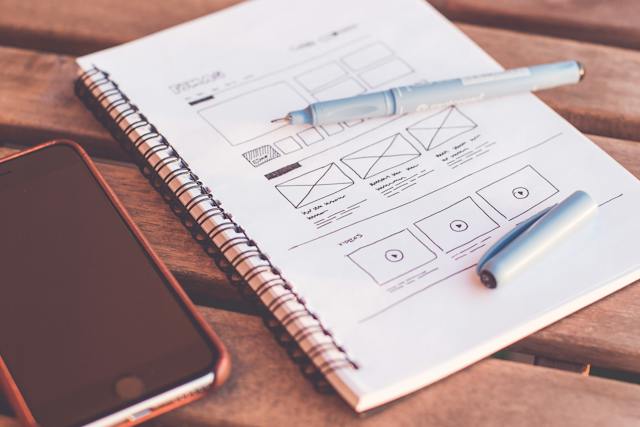In the blink of an eye, users size up your brand—0.05 seconds, no more. Your SaaS product, no matter its unique proposition or hefty features list, risks irrelevance without top-notch design and user experience. This guide breaks down the essence of compelling SaaS design with a focus on user-centric approaches.
Why design matters for SaaS user experience
A successful SaaS product relies on a well-designed user interface (UI). Initial impressions matter, and if users dislike the interface, they won’t give your application a chance. Design impacts users’ perception of quality and reliability. A dated or poorly designed SaaS website reduces trust.
Excellent UX design is crucial for the product’s success, prioritizing it early in development. A winning design provides a positive customer experience and differentiates your product from competitors. Furthermore, it complements your features and enables efficient scalability as your product grows.
User centric vs. product centric design
A product-centric approach focuses on building and launching products with innovation in mind, pushing boundaries to offer new solutions. In contrast, a user-centric approach prioritizes providing a positive user experience by understanding and addressing user needs, fostering loyalty through problem-solving.
A user-centric approach aims to satisfy users and alleviate their pain points. Long-term success is achieved by nurturing user relationships and delivering a great user experience, rather than solely focusing on market comparisons of product features.
User-centric organizations invest in user research and analysis to understand needs accurately. They prioritize enhancing the overall experience to build a loyal customer base, leading to higher renewals and upsell rates.
Challenges in user-centric SaaS functionality
In the quest for customer acquisition and retention, the ease of use in SaaS products holds significant importance. However, there are pitfalls to be mindful of in the SaaS UX design process. Let’s explore a few:
- Complex user interfaces: Just as a cluttered room can overwhelm and confuse its occupants, complex interfaces can leave users feeling lost and frustrated. To prevent this, streamline the user journey, remove unnecessary elements, and ensure that vital features are easily discoverable.
- Lack of user feedback: Building a SaaS product without gathering user feedback is like trying to navigate a new city without a map or local guidance. User feedback is invaluable in understanding their needs and preferences. Designers should create functional prototypes, conduct regular testing, and actively listen to users to make informed design decisions and drive product improvements.
- Performance issues: Imagine driving on a road filled with potholes and traffic congestion—it would hinder your progress and frustrate you. Similarly, slow or unresponsive interfaces impede the user experience. Designers must prioritize seamless navigation and optimize the product’s performance to provide a smooth and efficient experience.
Creating a user-focused product vision
When working with a product vision in SaaS development, it’s key to keep your users at the heart of everything. Here’s how you can do that:
- Getting to know your users: Learn as much as you can about your users. What do they like? What do they struggle with? User research, feedback, and behavior analysis are great ways to get this insight and build your product vision.
- Including stakeholders: Get key stakeholders involved in shaping the product vision. With input from development, design, marketing, and customer support, you can create a vision that covers all bases.
- Setting solid goals: Set clear and SMART (Specific, Measurable, Achievable, Relevant, Time-bound) goals for your product. These should tie in with what your users need and give a clear path for your development work.
- Crafting a powerful story: Tell a story that communicates your product vision in a way that hits home with your team and your users. This should cover what makes your product valuable and the difference it could make to your users.
Attaining a user-focused mindset
A user-focused approach and a clear product vision are key, but they also need a shift in how your development team thinks. Here’s what to keep in mind:
- Iterative development: Work in a way that allows for quick feedback and regular tweaks. This makes it easier for teams to meet user needs and adjust the product vision when necessary.
- Regular user feedback: Get user feedback throughout the development process. This helps confirm ideas, find pain points, and adjust the product vision as needed.
- Data-driven decision-making: Use data and analytics to inform your decisions. With user metrics, behavior patterns, and market trends, you can confirm your product vision and make data-driven changes as needed.
User-centric approaches for effective SaaS UX
Now that we’ve outlined the key research goals of UX research for SaaS, let’s look at some practical steps to achieve them.
Use user-friendly language
In many SaaS platforms, technical or industry-specific jargon is used in the user interface text. While this may seem daunting, it actually simplifies the product for those in the industry, a key aspect of a good user interface. While simple language is often preferred in app copywriting, SaaS can be an exception. Using technical language for technical products boosts credibility with your audience.
Adopt a design thinking approach
Design thinking puts the user at the heart of the process. It aims to improve user understanding through collaboration and design, which involves the following steps:
- Start by engaging with real users to understand their objectives.
- Identify and define problems, and consider potential solutions.
- Brainstorm with your team to identify specific UX research methods for your SaaS products.
- Build prototypes, incorporating best tips and practices from SaaS UX research.
- Test these prototypes and refine your understanding of how users interact with your SaaS product.
Design thinking is a process that culminates in creating a software prototype based on user needs research. To effectively accomplish this, it’s necessary to perform A/B functional testing for adequate prototyping and evaluation. Implementing design thinking in UX research for SaaS builds trust and confidence with users.
Create intuitive navigation
Attractive features may draw users in, but it’s usability that makes them stay. Regardless of how packed with features or distinctive your SaaS website may be, it shouldn’t be a maze for users to navigate.
Keep in mind, most of a user’s time is spent on other sites. They anticipate that your site will work in a way that’s similar to those they frequent. Familiarity is a preference for users. To ensure your SaaS app feels instinctive, consider mirroring popular models that users already know. This way, they can concentrate on using your application rather than figuring out how it works.
This guideline is known as Jakob’s Law. Despite the vast array of possible designs, designers should aim to create systems that align with users’ general expectations of how a website or application should operate. Refrain from crafting a distinctive design just for the sake of being different. Instead, emphasize on designing a navigation structure and overall UI layout that feels familiar. This approach will let users interact with your SaaS app intuitively.
Focus on onboarding and accessibility
A user-friendly onboarding process is key for a great user experience. Aim to make the first encounter with your SaaS app straightforward. Use tooltips for guidance, tutorial videos, or walkthroughs for initial setup. For example, Dropbox shines here. New users get a quick tour to learn the layout and features of the platform.
Also, remember to design your SaaS app for all users, including those with disabilities. Not only does an accessible design meet legal standards, but it also enhances usability for everyone. Include features like text-to-speech for those with visual impairments or captions for hearing-impaired users. Take a leaf out of Microsoft Office 365’s book. It offers a built-in screen reader, text-to-speech, and keyboard shortcuts to help all users navigate and use their suite with ease.
Top SaaS UI design examples
Here are notable SaaS UX designs that adhere to effective practices and serve as inspiration.
- Personalized onboarding in Slack: Slack is recognized for its unique onboarding process, which feels custom-made for each user. First-time users get a clear glimpse of the application’s UI, making the introduction engaging and enjoyable.
- Simplicity in Jotform: Jotform, a straightforward SaaS application, is admired for its simplicity. Numerous templates are available, which users can modify with ease, without needing to learn complex processes.
- Impressive web presence of Canva: Canva, a modern design platform, stands out for its overall web presence, including its website and social media channels. Prioritizing user needs, Canva employs top SaaS UX design practices, enhancing the overall user experience.
- HubSpot’s efficient information architecture: HubSpot, a popular SaaS platform, is successful due to its efficient information architecture. Its interface is easy to navigate, and content is organized so well that users can accomplish their tasks without feeling overwhelmed.
User-centric design trends in SaaS
As we delve into the current trends shaping SaaS UX design, a key theme emerges: simplicity and clarity. Designers are increasingly embracing a minimalist approach, focusing on a two-color palette for a clean and modern aesthetic.
The Robinhood stock trading app, for example, primarily uses shades of green and white, demonstrating how less can be more. Moreover, the spotlight is on value proposition. It’s crucial to convince users upfront about the superiority and utility of the SaaS application. This is usually done by prominently displaying the value proposition on the homepage, like Notion does with its tagline, “One workspace Every team.”
The rise of video tutorials is another notable trend. If quick onboarding isn’t enough to understand how the SaaS product works, an educational and entertaining video tutorial is offered as a user-friendly alternative. Wix, for instance, has a YouTube channel full of tutorials to guide users in understanding their application.
Designers are also introducing dark mode options into their SaaS UX designs. B2B SaaS solutions are often accessed for extended periods, and a dark mode can reduce eye strain and enhance visual clarity. Plus, it also uses less battery power, an added bonus for users. Netflix, with its dark theme, exemplifies this trend well.
Finally, in an era of pervasive smartphone use, SaaS applications are prioritizing mobile-friendly designs to broaden their reach and make services more accessible. Even though web apps remain preferred for office workers, a mobile version has become a necessity. Careem, the leading ride-hailing app based out of Dubai, is a prime example of providing a stellar mobile-friendly user experience.
Conclusion
Jumping headfirst into the dynamic world of UI/UX design, you might soon find yourself face-to-face with the unique challenge of designing SaaS applications. To gear up for these projects, it’s crucial to appreciate the nuances that set SaaS UX apart from other design facets, like customer-facing products or enterprise UX. The core principles largely remain consistent, yet a few distinctive differences can shape your design approach and the eventual outcomes.
Dive into the examples and best practices detailed in this article as your launchpad for SaaS application design. Be ready to tweak these guidelines to cater to the specific user needs, service characteristics, and organizational objectives. As you wrap your head around the ins and outs of SaaS UX design, you can enrich your portfolio with more intriguing projects and cement your foothold in the UX design world.


